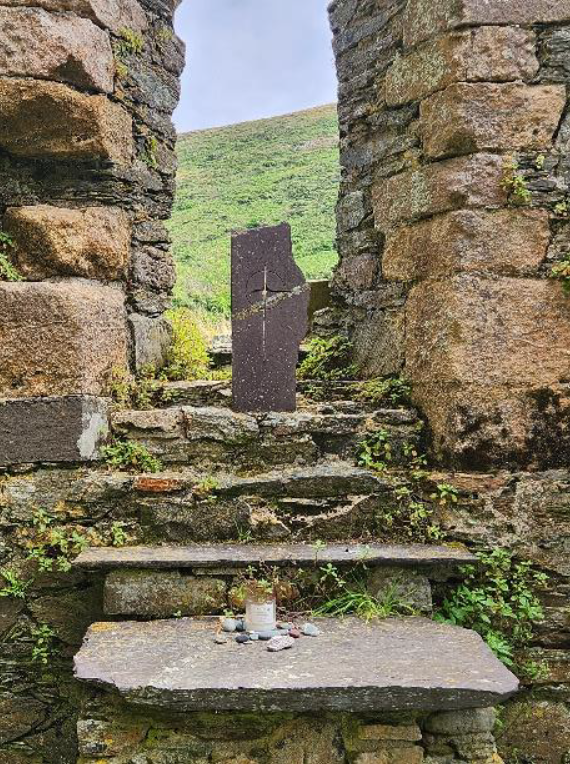THERE AND BACK AGAIN
It was good to be home last Thursday and to be with everyone at Saturday’s Food Truck fundraiser as well as in Sunday’s worship. I had a wonderful time walking a large section of the North Wales Pilgrimage Path along the Llyn Peninsula in Wales from Bangor to Aberdaron – a distance of about 70 miles in five days.
The Llyn Peninsula is one of the areas where Welsh-speakers predominate. It was a curious experience to be in what we assume to be an English-speaking Britain surrounded by people speaking Welsh and the signage in stores mostly in Welsh and (sometimes) English. I went into a bookstore in Caernarfon thinking I’d buy a book to read in the evenings only to discover that many of its books were in Welsh.
Only on the Saturday of my walk did I encounter a few other hikers, most of whom were doing short-hikes to take a break from the beaches below the cliffs. I had long hours unincumbered by my mobile phone, which didn’t work consistently due to a lack of reception, ands email. Along with countless flocks of sheep, I saw plenty of seabirds and a few seals lounging on the rocky beaches.
My final destination was Aberdaron and, just off-shore, Bardsley Island. Aberdaron is associated with one of Wales’ most important 20th-century poets, R.S. Thomas, who was priest at the small Church of Wales congregation there – St. Hywyn. I was fortunate enough to arrive at the end of an annual gathering of a poetry society dedicated to studying Thomas’ poetry at which the Church of Wales’ archbishop was preaching for the Sunday service.
But my ultimate goal was Bardsley Island. Its Welsh name, Ynys Enlli, means “Isle of Currents” the strong, unpredictable tides and currents make it a treacherous crossing to the island. There are basically no year-round residents on the island, which is about one mile long and around one-half mile wide. A few guest cottages are leased out on a one-week basis to bird enthusiasts who stay at the Bird Observatory to count and observe puffins, clough chicks, guillemots, European shags, oystercatchers, and others. One highlight was seeing not just nesting puffins but fluffy puffin chicks. I also sat for a long time on a bluff near the lighthouse watching about 100 grey seals sun themselves and play on the beach below me.
But birdwatching wasn’t what drew me to Bardsley Island. Since at least the 6th-century it has been a pilgrimage destination for Christians. It is known as the “island of 20,000 saints” and in the 12th-century Pope Callixtus II proclaimed that three pilgrimages to Bardsley Island were equivalent to a pilgrimage to Rome. An early Welsh saint, St. Cadfan, established his hermit cell there in 615 CE. Soon other hermits and monks joined him. Because of the sanctity of Cadfan and his disciples, the belief arose that whoever died and was buried on Bardsley would not go to hell. Which apparently was a big incentive to journey there shortly before your death and be buried there.
It was also an important holy site long before Christianity arrived in Wales. Welsh legends say Bardsley Island is the original Avalon of King Arthur and is where Excalibur was forged. It’s said to be where Arthur was taken after being wounded by Mordred and there he still lies to this day sleeping in a cave on the island, awaiting the day of Britain’s direst need, when he will rise up to save the nation. It’s also said that Merlin sleeps on Bardsley Isand in a magic glass castle surrounded by the Thirteen Treasures of Britain and attended by nine bardic companions, all of who are waiting for Arthur’s command to awake and join him.
This aura of saints and Arthurian legends suggests that Bardsley Island has long been recognized as a “thin place” or a gateway to another dimension of experience and perception. Donald Allchin, a 20th-century Anglican spiritual writer, describes Bardsley as “a door through which we can pass to another world.” It is one of those places we are invited to kneel and pray where prayer has been valid, as T.S. Eliot wrote in “Little Giddings.” I left a small stone I’d carried with me as a symbol of my intentions at a simple altar inside the ruins of the abbey dedicated to St. Mary built in 1188 and expanded in the 13th century.

For me, what made it a still more spiritual place than its legends and saints was the night sky. Bardsley was designated in 2023 as a Dark Sky Reserve, a place where one can see the night sky without the light-pollution that obscures the stars, planets, and galaxies in so much of our contemporary world. More than the landscape with its seals and puffins and strong waves, the night sky evoked wonder in me. “When I look at your heavens, the work of your fingers, the moon and the stars that you have established; what are humans that you are mindful of them, mortals that you care for them?” (Psalm 8:3-4).
It was a wonderful pilgrimage for me to a place I’ve long wanted to visit. One of R.S. Thomas’ poems entitled “Arrival” expresses much of what I experienced and learned; and, of course, you shouldn’t have to walk across Wales to know what he is describing:
Not conscious
that you have been seeking
suddenly
you come upon it
the village in the Welsh hills
dust free
with no road out
but the one you came in by.
A bird chimes
from a green tree
the hour that is no hour
you know. The river dawdles
to hold a mirror for you
where you may see yourself
as you are, a traveller
with the moon’s halo
above him, whom has arrived
after long journeying where he
began, catching this
one truth by surprise
that there is everything to look forward to.
Blessings,
Pastor Thomas
